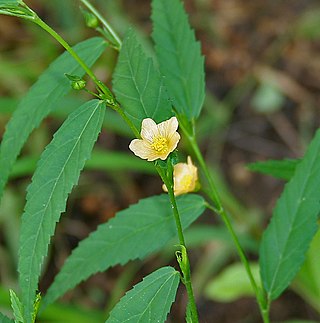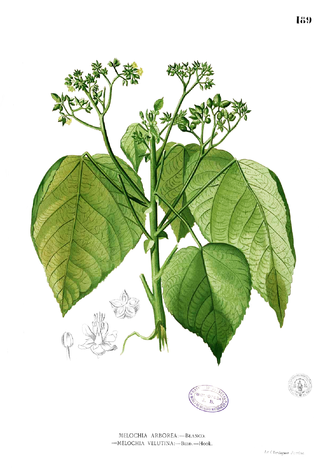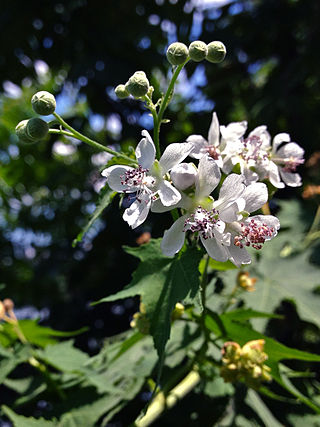
Callirhoe is a genus of flowering plants in the mallow family, Malvaceae. Its nine species are commonly known as poppy mallows and all are native to the prairies and grasslands of North America. Of the nine species, some are annuals while others are perennial plants.

Abutilon is a large genus of flowering plants in the mallow family, Malvaceae. It is distributed throughout the tropics and subtropics of the Americas, Africa, Asia, and Australia. General common names include Indian mallow and velvetleaf; ornamental varieties may be known as room maple, parlor maple, or flowering maple. The genus name is an 18th-century Neo-Latin word that came from the Arabic ’abū-ṭīlūn, the name given by Avicenna to this or a similar genus.

Theobroma is a genus of flowering plants in the mallow family, Malvaceae, that is sometimes classified as a member of Sterculiaceae. It contains roughly 20 species of small understory trees native to the tropical forests of Central and South America.

Corchorus is a genus of about 40–100 species of flowering plants in the family Malvaceae, native to tropical and subtropical regions throughout the world.

Sida cordifolia is a perennial subshrub of the mallow family Malvaceae native to India. It has naturalized throughout the world, and is considered an invasive weed in Africa, Australia, the southern United States, Hawaiian Islands, New Guinea, and French Polynesia. The specific name, cordifolia, refers to the heart-shaped leaf.

Sida rhombifolia, commonly known as arrowleaf sida, is a perennial or sometimes annual plant in the Family Malvaceae, native to the Old World tropics and subtropics. Other common names include rhombus-leaved sida, Paddy's lucerne, jelly leaf, and also somewhat confusingly as Cuban jute, Queensland-hemp, and Indian hemp. Synonyms include Malva rhombifolia. It is used in Ayurvedic medicine, where it is known as kurumthotti.

Dodonaea is a genus of about 70 species of flowering plants, often known as hop-bushes, in the soapberry family, Sapindaceae. It has a cosmopolitan distribution in tropical, subtropical and warm temperate regions of Africa, the Americas, southern Asia and Australasia. By far the highest species diversity is in Australia. The genus is named after Rembert Dodoens, traditionally known as 'Dodonaeus'.

Sida fallax, known as yellow ilima or golden mallow, is a species of herbaceous flowering plant in the Hibiscus family, Malvaceae, indigenous to the Hawaiian Archipelago and other Pacific Islands. Plants may be erect or prostrate and are found in drier areas in sandy soils, often near the ocean. ʻIlima is the symbol of Laloimehani and is the flower for the islands of Oʻahu, Hawaiʻi, and Abemama, Kiribati.
Wireweed may refer to several organisms, including:

Lasiopetalum, commonly known as velvet bushes, is a genus of about forty-five species of flowering plants in the family Malvaceae, all endemic to Australia.

Malva sylvestris is a species of the mallow genus Malva in the family of Malvaceae and is considered to be the type species for the genus. Known as common mallow to English-speaking Europeans, it acquired the common names of cheeses, high mallow and tall mallow as it migrated from its native home in Western Europe, North Africa and Asia through the English-speaking world.

Crocidosema plebejana, the cotton tipworm, is a tortrix moth, belonging to tribe Eucosmini of subfamily Olethreutinae. It is found today all over the subtropical and tropical regions of the world and even occurs on many oceanic islands – in Polynesia and Saint Helena for example – but has probably been accidentally introduced to much of its current range by humans. In addition, it is also found in some cooler regions, e.g. in Europe except in the east and north; this is probably also not natural, as it was, for example, not recorded in the British Isles before 1900.

Sida acuta, the common wireweed, is a species of flowering plant in the mallow family, Malvaceae. It is believed to have originated in Central America, but today has a pantropical distribution and is considered a weed in some areas.

Malvella is a small genus of flowering plants in the mallow family, Malvaceae. There are four species, one native to the Mediterranean, and three native to the southwestern United States and Mexico. The plants were formerly classified in genus Sida.

Radyera is a genus of flowering plants in the family Malvaceae.

Melochia is a genus of flowering plants in the mallow family, Malvaceae. It comprises 54 species from the tropical and subtropical regions of the world, ranging from India eastwards through Malesia and the Pacific Islands to the Americas and the Caribbean.

Sida hermaphrodita, known by the common names Virginia fanpetals and Virginia mallow, is a perennial forb native to the eastern United States, which produces white flowers in summer.

Calligrapha pantherina, the sida leafbeetle, is a species of beetle in the family Chrysomelidae, endemic to Mexico. The larvae and adult beetles feed on the foliage of the common wireweed and the arrowleaf sida. This beetle has been introduced into Northern Australia as a biological control agent in an attempt to control its host plants, which are invasive weeds there.





















